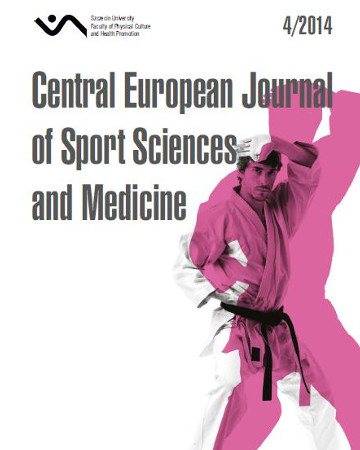
ISSN: 2300-9705
eISSN: 2353-2807
OAI




Issue archive /
Vol. 8, No. 4/2014
Total Energy Cost- Aerobic and Anaerobic, Exercise and Recovery- of Five Resistance Exercises
| Authors: |
Ann
Knausenberger
Human Performance Laboratory, University of Southern Maine, USA Alex Luchini Human Performance Laboratory, University of Southern Maine, USA Christopher B. Scott Human Performance Laboratory, University of Southern Maine, USA Abigail Steitz Human Performance Laboratory, University of Southern Maine, USA |
| Keywords: | anaerobic energy expenditure intermittent exercise work |
| Data publikacji całości: | 2014 |
| Page range: | 7 (53-59) |
Abstract
We utilized a non-steady state method (kJ per set, not kJ min–1) to estimate the total energy costs (aerobic and anaerobic, exercise and recovery) of five different resistance exercises: incline bench press, squat, deadlift, shoulder shrug and calf raise. Using a Smith machine, work was precisely measured as the product of the vertical distance the lifting bar traveled and the amount of weight lifted. The average of two lifts performed on separate days was completed by 16 women (165 cm; 61.1 kg; 21.8 years) and 22 men (180.5 cm; 83 kg; 23.7 years). Overall 40 data points (the averages of 80 lifts) were plotted and correlations completed within each exercise for work and total energy costs: deadlift r = 0.997, squat r = 0.977, incline press r = 0.947, shoulder shrug r = 0.921 and calf raise r = 0.941 (p < 0.05). The amount of oxygen consumed during exercise for each lift represented the lowest energy cost contribution (18%), followed by anaerobic (31%) and excess post-exercise oxygen consumption (EPOC, 51%) (p < 0.05). The identification of work (J) along with an estimate of the total energy costs (kJ) revealed remarkably consistent relationships within any given resistance exercise, leading to a predictable increase in the cost of lifting for each exercise. However, due to the muscle/joint and movement characteristics of each exercise, the work to cost relationship differed for all lifts.
Download file
Article file
Bibliography
| 1. | Buitrago S., Wirtz N., Flenker U., Kleinoder H. Physiological and metabolic responses as function of the mechanical load in resistance exercise. Appl Physiol Nutr Metab. 2014; 39: 345–350. |
| 2. | Gorostiaga E.M., Navarro-Amezqueta I., Calbet, J.A.L., Sanchez-Medina L., Cusso R., Guerrero M., Granados C., Gonzalez-Izal M., Ibanez J., Izquierdo M. Blood ammonia and lactate as markers of muscle metabolites during leg press exercise. J Strength Cond R |
| 3. | Hoeger W.W.K., Barette S.L., Hale D.F., Hopkins D.R. Relationship between repetitions and selected percentages of one repetition maximum. J Appl Sport Sci Res. 1987; 1: 11–13. |
| 4. | Kerksick C.M., Mayhew J.L., Grimstvedt M.E., Greenwood M., Rasmussen C.J., Kreider R.B. Factors that contribute to and account for strength and work capacity in a large cohort of recreationally trained adult healthy men with high and low strength levels. |
| 5. | McBride J.M., McCaulley G.O., Cormie P., Nuzzo J.L., Cavill M., Triplett N.T. Comparison of methods to quantify volume during resistance exercise. J Strength Cond Res. 2009; 23: 106–110. |
| 6. | Scott C.B. Contribution of blood lactate to the energy expenditure of weight training. J Strength Cond Res. 2006; 20: 404–411. |
| 7. | Scott C.B. Combustion, respiration and intermittent exercise: a theoretical perspective on oxygen uptake and energy expenditure. Biology 2014a; 3: 255–263. |
| 8. | Scott C.B., Earnest C.P. Resistance exercise energy expenditure is greater with fatigue as compared to non-fatigue. J Exer Physiol online. 2011; 14: 1–10. |
| 9. | Scott C.B., Croteau A., Ravlo T. Energy expenditure before, during and after the bench press. J Strength Cond Res. 2009; 23: 611–618. |
| 10. | Steele J., Fisher J., McGuff D., Bruce-Low S., and Smith D. Resistance training to momentary muscular failure improves cardiovascular fitness in humans: a review of acute physiological responses and chronic physiological adaptations. J. Exer Physiol onlin |
| 11. | Steudel-Numbers K.L., Wall-Scheffler C.M. Optimal running speed and the evolution of hominin hunting strategies. J Hum Evol. 2009; 65: 355–360. |
| 12. | Vezina J.W., Der Anian C.A., Campbell K.D., Meckes N., Ainsworth B.E. An examination of the differences between two methods of estimating energy expenditure in resistance training activities. J Strength Cond Res. 2014; 28: 1026–1031. |